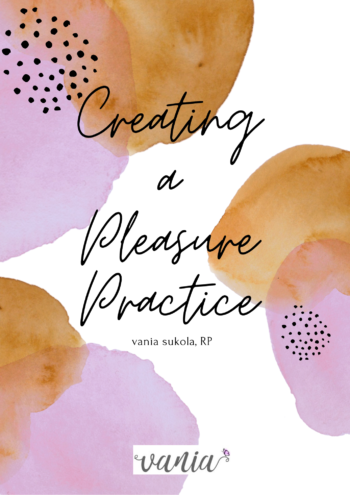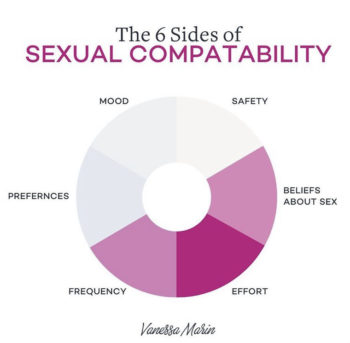I recently completed a course that I have been wanting to take for years. After being a student at University of Guelph for my undergrad, it had always been a dream of mine to take their intensive sex therapy course. I can now share the exciting news that I’ve completed it! While I’ve already been offering couple and relationship counselling as well as sexual health and sexual violence healing, this new training has offered a further breadth of support I can offer.
One of the final assignments of the course was to put together a pleasure practice guide. As this is something I’ve been working on in my own life and supporting others with, I’m sharing with you now some of the ways that you can start or enhance your pleasure practice.
It might be hard to access what you find pleasurable sexually, if you don’t already have a sense of it in your daily life outside of the bedroom. This guide is a great place to start. Each day, commit to some time to try out how you might add an intentional way to reflect on how to bring pleasure into your life.
In the amazing book, Pleasure Activism, adrienne marie brown shares that you find your pleasure path when you have embodied joy, happiness, satisfaction and connection. This is the embodiment of a pleasure practice.

As a somatic therapist, I created this guide to start from the bottom-up, instead of staying in our brain and thoughts. Using the 5 senses, pick one a day to see what brings you pleasure. This practice is about attuning to what gives you that felt sense of pleasure. If some of the senses are not available or accessible for you, focus on the ones that are. Notice if you can also connect any of these sensory anchors to what your core fantasy might also include.
Over the course of a week, spend some time daily just thinking about each of these and see how you can incorporate time to play with them. Each day, over the course of the day, focus on one sense. On the final day, combine the practices and set the scene. You don’t have to do them in order as presented, but try to do all 7 days. Repeat a theme if you have an abundance of ideas, need a do-over, or one sense is not available to you.
End the week by bringing in all five senses and save this last one to set your scene up for success. Set the room with the items that evoke pleasure, and see what happens when you bring it all together. Maybe you want to get candles, a cozy blanket, chocolate and wine. Put on some playful music, and wear a sexy camisole. Or how about setting up your backyard with a private oasis. Surround yourself in nature. Rest your feet or sit right on the earth. Take your undies off and sit right on the grass (thanks to amb for this gift!) Remember the goal is not necessarily sex but rather an embodied sense of harnessing your own pleasure.
Journal your reflections – what did you notice? What surprised you, would you do again, differently? What felt like it was missing something?
In last month’s article, i shared the idea of a Core Erotic Theme. If you haven’t spent time with it already, this is a perfect opportunity to create one. Think of what your Core Erotic Fantasy is now that you have spent some time discovering your pleasure path.
If you want to learn more, here are some great resources that speak further about this. I especially love adrienne maree brown’s book Pleasure Activist and that reminder that we all have a right to embody pleasure. Esther Perel’s body of work on pleasure is also a must. She recently did a workshop on enhancing foreplay pleasures. With topics on ritual, desire, exploring the senses, imagination and setting the right ambiance, this is a great resource. Blaire Lindsay’s free webinar series on finding your Pleasure Path also has some great activities. Rachael Maddox created this lovely gift as well.

While i said that this practice is for yourself, and i truly mean it as a stand-alone gift to yourself, it is also a great way to create more attuned intimacy with your lover. When new parents struggle with desire discrepancy, a new take on creating pleasure is a great way to get back on track. When new couples are trying to get connected in bed, this resource can be a great starting point. Or, for survivors of sexual violence, abuse or boundary violations, working on a pleasure practice can be a beneficial step to become clearer with how to meet your sexual desires with others. Vanessa Marin has great visual aid to help folx have a better sense of their sexual compatibility. Looking at this graphic, can you discern what might be lacking in your own relationships, what you can work on, or what is on fire?
Remember, the goal for finding your pleasure path is not to be sexually intimate with others, and yet it is so helpful to notice what feels compatible with others’ paths.
Now that you are starting your path to pleasure, you can get a sense of your compass or guide. Think of it as your ‘love pulse’ – it is your divine witness. Every once in a while, spend some time checking in with your love pulse – if it feels low, it may be time for a pleasure practice!

